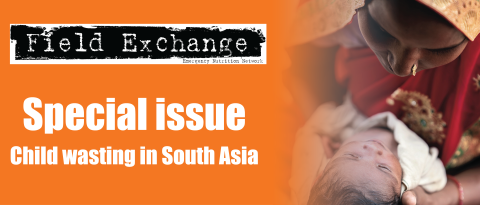Effectiveness of programme approaches to improve the coverage of maternal nutrition interventions in South Asia
Summary of research1
The nutritional status of women before and during pregnancy and after delivery has far-reaching consequences for maternal health and child survival, growth and development. Women who are short, thin and anaemic or who gain inadequate weight during pregnancy are more likely to suffer adverse birth outcomes, including low birth weight (LBW) and preterm delivery. Severe anaemia and calcium deficiency, two leading causes of maternal death globally, increase the risk of postpartum haemorrhage and hypertensive disorders respectively. Progress in improving women’s nutrition in South Asia has been made; over the last 15 years, low stature (<145 cm) in women of reproductive age has declined by at least 20% in three out of four countries with available data, and low body mass index (BMI; <18.5 kg/m2) has fallen by at least 30% in all four countries. However, progress is not swift enough as around one in 10 women in South Asia still have a low stature and one in five still have a low BMI.
Given the close links between maternal and child nutrition, efforts to improve the nutritional status of women are critical to attaining the global nutrition targets of the Sustainable Development Goals and the World Health Assembly and in unleashing the developmental potential of children and the economic development of South Asian nations. In 2016, the World Health Organization (WHO) released guidelines on improving antenatal care (ANC) for women, including a comprehensive set of recommendations on nutrition interventions during pregnancy. In light of the poor maternal nutrition indicators in South Asia and poor coverage of evidence-based interventions, a systematic review (2000-2017) was conducted to identify drivers and barriers to the coverage of maternal nutrition interventions and examine the evidence on the effectiveness of programme approaches and actions to improve coverage.
The search strategy selected nine studies, conducted in Bangladesh (two), India (five), Nepal (one), and Pakistan (one). Outcomes included the receipt and consumption of iron and folic acid (IFA) and calcium supplements and the receipt of information on dietary intake during pregnancy. Supplementation with multiple micronutrients was not included as it is not a recommended nutrition intervention in the WHO (2016) guidelines on ANC.2 Data were synthesised by type of maternal nutrition intervention and type of barrier to coverage or adherence to the intervention.
Findings indicate that a range of barriers acting at the individual (maternal), household and health-service delivery level affect whether a woman receives maternal nutrition interventions and, in the case micronutrient supplementation, whether she consumes the supplements. Programme approaches that were effective in increasing the receipt of services and/or consumption of supplements used a combination of actions to address barriers at multiple levels. Predictors of the receipt and consumption of IFA and calcium supplements in Bangladesh, India and Pakistan included early and more frequent ANC visits, higher maternal education, higher paternal education, higher maternal knowledge, increased household wealth, access to counselling services and a higher level of support from husbands. These enablers confirm previous findings on IFA supplementation that point to the role of women’s knowledge and empowerment, household resources, women’s access to health services and the quality of health services in determining whether women receive and consume supplements and adopt positive dietary practices. All programmes that delivered information and counselling to women and their family members, often in combination with other programme actions, significantly improved the receipt and consumption of IFA and calcium supplements and the receipt of information on a diverse diet during pregnancy.
Programme approaches that were effective in improving intervention coverage addressed barriers at multiple levels and had several common features. First, they used formative research and ethnography to adapt the design of programme actions to the context-relevant barriers faced by women in accessing services or adopting recommended nutrition behaviours. This included the design of locally relevant information and counselling materials. Second, they engaged with and enlisted the support of influential family members, including husbands and mothers-in-law, to ensure pregnant women accessed services and adopted positive behaviours, thereby countering women’s low decision-making authority. Third, they introduced home visits and community forums to increase the access of pregnant women, influential family members and other community leaders to interventions. Fourth, they developed the capacity of frontline workers to provide information and counselling to women, family members and other community members (and, in Bangladesh, added mechanisms to supervise, monitor and motivate their performance).
The two programmes that examined the effectiveness of mobile health applications to improve service delivery by frontline workers were not effective in increasing the receipt or consumption of IFA supplies. It is likely that mobile health approaches alone will not be effective if other barriers to receipt or consumption of IFA, such as a lack of IFA supplies, are not addressed.
The evidence base on what works to improve the coverage of maternal nutrition interventions in South Asia is very small. Greater attention is needed in all country settings in South Asia on resourcing and conducting formative and implementation research to better understand the pathways, enablers and barriers to improving the access to all maternal nutrition interventions recommended by the WHO ANC guidelines (2016), including the quality of counselling and adoption of positive maternal nutrition behaviours.
Endnotes
1 Goudet S, Murira Z, Torlesse H, Hatchard J, Busch Hallen J. Effectiveness of programme approaches to improve the coverage of maternal nutrition interventions in South Asia. Matern Child Nutr. 2018;14(S4): e12699. https://doi.org/10.1111/mcn.12699
2 See research article in this issue ‘Prevention of child wasting in Asia: Possible role for multiple micronutrient supplementation in pregnancy’


